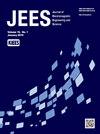具有5G NR性能验证的毫米波GaN MMIC前端模块
IF 1.7
3区 工程技术
Q3 ENGINEERING, ELECTRICAL & ELECTRONIC
Journal of electromagnetic engineering and science
Pub Date : 2022-11-30
DOI:10.26866/jees.2022.6.r.133
引用次数: 0
摘要
本文提出了一种基于多个氮化镓(GaN)单片微波集成电路(mmic)的毫米波(mmWave) 5G前端模块(FEM),并进行了5G新无线电(NR)性能验证。该结构由一个宽带GaN单极双丢(SPDT)开关MMIC、一个GaN低噪声放大器(LNA) MMIC和一个GaN功率放大器(PA) MMIC组成,目标工作频带为26.5 GHz至29.5 GHz。LNA和PA MMIC采用150 nm GaN/SiC技术设计,SPDT MMIC采用100 nm GaN/Si技术设计。LNA MMIC显示,在工作频带内测量到的噪声系数小于或等于2.52 dB。PA MMIC基于两级配置,测量饱和功率约为35 dBm,在工作频带内的功率附加效率优于34%。此外,SPDT MMIC基于宽带性能的人工传输线配置,并表明在工作频带内测量的插入损耗小于1.6 dB,测量的隔离度高于25 dB。此外,所有mmic都作为FEM集成在单个载波中,并通过5G NR测试信号成功验证。本文章由计算机程序翻译,如有差异,请以英文原文为准。
A Millimeter-Wave GaN MMIC Front End Module with 5G NR Performance Verification
This paper proposes a millimeter-wave (mmWave) 5G front end module (FEM) based on multiple gallium nitride (GaN) monolithic microwave integrated circuits (MMICs) with 5G new radio (NR) performance verification. The proposed structure is configured by a wide band GaN single-pole double-throw (SPDT) switch MMIC, a GaN low-noise amplifier (LNA) MMIC, and a GaN power amplifier (PA) MMIC with the target operation band from 26.5 GHz to 29.5 GHz. The LNA and PA MMICs are designed with 150 nm GaN/SiC technology, and the SPDT MMIC is designed with 100 nm GaN/Si. The LNA MMIC shows the measured noise figure less than or equal to 2.52 dB within the operation band. The PA MMIC is based on a two-stage configuration and shows about 35 dBm measured saturated power with power-added efficiency better than 34% within the operation band. Also, the SPDT MMIC is based on an artificial transmission line configuration for wideband performance and shows that the measured insertion loss is less than 1.6 dB, and the measured isolation is higher than 25 dB within the operation band. Furthermore, all MMICs are integrated within a single carrier as an FEM and successfully verified by 5G NR test signals.
求助全文
通过发布文献求助,成功后即可免费获取论文全文。
去求助
来源期刊

Journal of electromagnetic engineering and science
ENGINEERING, ELECTRICAL & ELECTRONIC-
CiteScore
2.90
自引率
17.40%
发文量
82
审稿时长
10 weeks
期刊介绍:
The Journal of Electromagnetic Engineering and Science (JEES) is an official English-language journal of the Korean Institute of Electromagnetic and Science (KIEES). This journal was launched in 2001 and has been published quarterly since 2003. It is currently registered with the National Research Foundation of Korea and also indexed in Scopus, CrossRef and EBSCO, DOI/Crossref, Google Scholar and Web of Science Core Collection as Emerging Sources Citation Index(ESCI) Journal. The objective of JEES is to publish academic as well as industrial research results and discoveries in electromagnetic engineering and science. The particular scope of the journal includes electromagnetic field theory and its applications: High frequency components, circuits, and systems, Antennas, smart phones, and radars, Electromagnetic wave environments, Relevant industrial developments.
 求助内容:
求助内容: 应助结果提醒方式:
应助结果提醒方式:


